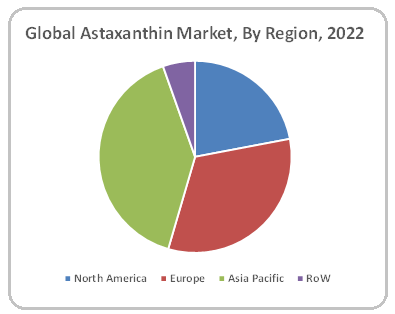According to the FDA, “Astaxanthin is the major carotenoid responsible for the pink-red pigmentation of fish and shrimps. Being a pigment, astaxanthin has been shown to have other biological and nutritional functions, linked to its ability to act as a powerful antioxidant.”
Astaxanthin, also called the “king of carotenoids,” occurs naturally in certain algae and imparts pink-red color in trout, lobster, shrimp, and other seafood. Its natural sources include microalgae, yeast, salmon, trout, krill, shrimp, crayfish, and crustaceans, while petroleum is a synthetic source. Astaxanthin is used as a pigmentation source in aquafeed and poultry. It is a powerful antioxidant having pharmaceutical applications and beneficial effects on various human diseases. It provides protection against DNA damage and UV light effects on eyes, also playing a significant role in immunological defense. Astaxanthin also has anti-inflammatory properties. Other health benefits associated with astaxanthin are cardiovascular disease prevention, boosting immunity, bioactivity against Helicobacter pylori, and cataract prevention.
Since astaxanthin improves animal health & vitality, it is widely used in feed. The benefits of astaxanthin for humans can be attributed to its antioxidant and anti-inflammatory properties. Hence, astaxanthin is widely used as a health supplement. Recently, its advantages have also been recognized in applications such as food and cosmetics.
Astaxanthin is synthesized from both natural and synthetic sources. Natural sources, which have no side effects, are the safest to consume. However, as the price of natural astaxanthin is comparatively higher, most feed applications utilize synthetic astaxanthin. Natural astaxanthin is mainly used for human consumption.
The global Astaxanthin Market USD 512.8 million in 2016. It is projected to reach USD 814.1 million by 2022, at a CAGR of 8.02% from 2018 to 2022. Expanding end-use applications of astaxanthin, rising awareness about preventive healthcare & nutraceuticals, growing demand of natural antioxidants, an ever-rising demand from emerging nations, the growing cosmetic & feed markets, and government initiatives to support aquaculture are among factors boosting the demand for astaxanthin.
Additionally, companies are investing in research & development to adjust the formulation of existing products and satisfy customer requirements. Large-scale players, including BASF SE (Germany), Koninklijke DSM N.V. (The Netherlands), and Fuji Chemical Industries Co., Ltd. (Japan) dominate the global market for astaxanthin. Other players include Cyanotech Corporation (U.S.), Valensa International (U.S.), Otsuka Pharmaceutical Co. Ltd. (Japan), and Algatechnologies (Israel).
In terms of use, feed is the largest application, which in 2016 held about 72% of the global astaxanthin production in 2016. Astaxanthin, which provides pigmentation and vitality to animals, has been used in animal feed since decades. The benefits of astaxanthin on humans was revealed just recently. Thus, the astaxanthin market for human consumption is at a nascent stage whereas the astaxanthin market for animal use is at a more advanced stage. Feed is followed by the supplements segment, which held about 18% of the global astaxanthin production in 2016.
Download PDF brochure for more details @
https://www.marketsandmarkets.com/pdfdownload.asp?id=162119410
The major players in the astaxanthin market are DSM (Netherlands), BASF SE (Germany), Cyanotech Corporation (US), Otsuka Pharmaceutical Co., Ltd. (Japan), Valensa International (US) and Fuji Chemical Industries Co., Ltd. (Japan). Expansion & investment, and new product launches, are the major strategies adopted by market players to achieve growth in the mushrooms market.
